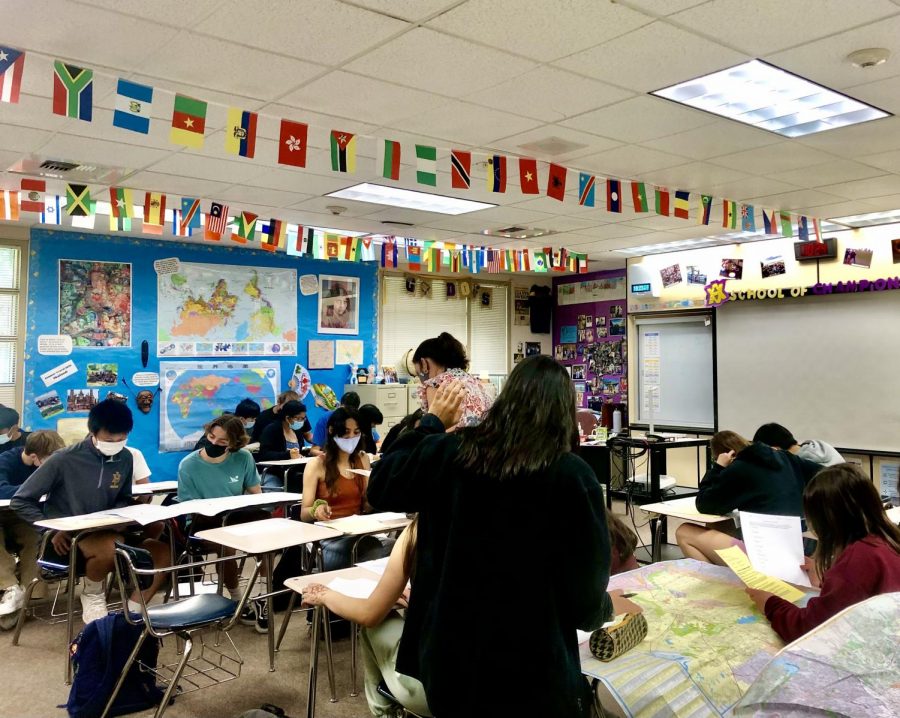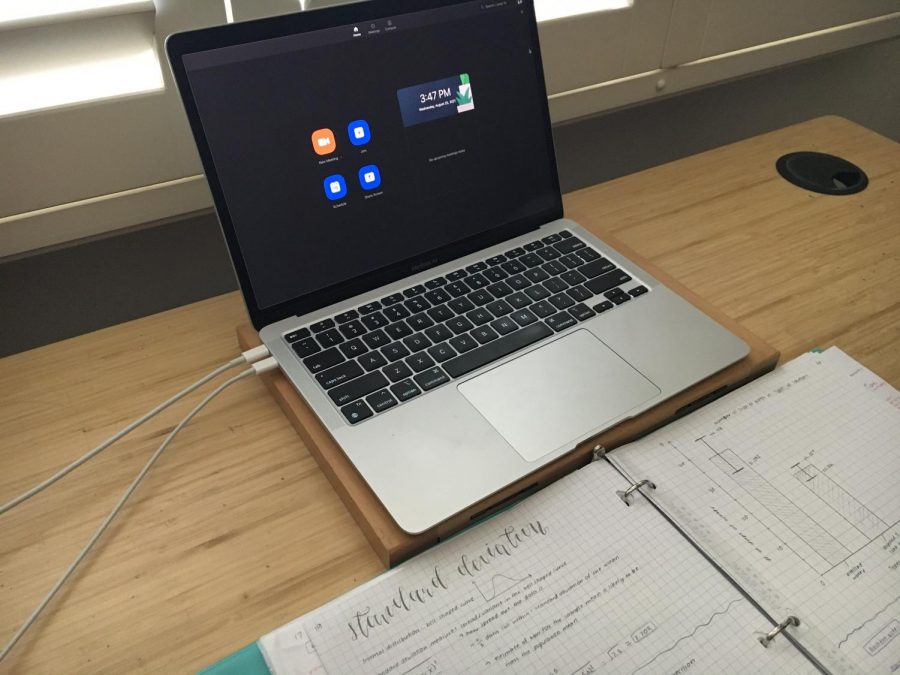FACE OFF: Should we return to online schooling?
August 26, 2021
With the news of Covid cases in our school, students and parents have grown more concerned about the safety of their children, and themselves. Do we risk safety, and continue immersive schooling? Or do we return to the safety of our homes, but decrease in learning capacity? Two students give their opinions.
School in-person will bring us enriching environments
Jennifer Zuanich, AP Human Geography teacher, leads the class to read and understand core learnings.
After a year of online schooling, students and teachers have been itching to come back to in-person schooling. As a result of the CDC’s new school guidelines, Dons were able to start in-person schooling on August 11, even holding our first ever rally in two years.
Last year’s schooling was a shift from the norm, holding zoom meetings for 4 hours in the morning, with assigned asynchronous homework given for the second half of the school day. However, there were many problems with that style of learning and teaching.
Many students did not have the motivation to participate in class, such as teacher-facilitated discussions, and even more, fell behind on schoolwork because of household, and extracurricular responsibilities.
“It was just very difficult through a computer screen to create that same sort of enthusiasm and collaboration. Zoom breakout rooms were really quiet and oftentimes awkward,” said English teacher Sara Marek.
Due to the new in-person schooling, the motivation to teach has risen for Amador teachers.
“Now, you know if they’re engaged with you, because you can see their eyes and you can see what they’re doing on paper, or on their Chromebooks. You can walk around and see all that,” said Marek.
Students have also shown more interest in subjects, and they are readily accepting of work. Most are looking forward to learning in their classes.
One negative aspect of remote learning was the lack of social interaction for students. Because of the all-virtual mode of learning, students had no way of talking with peers, friends, and teachers. Forced to find new ways of interacting, students took to online apps, such as Instagram, and Snapchat, yet many of them still felt isolated from their close friends.
“The pandemic distanced me from people I only interacted with at school, so I had to download different apps like snapchat or discord to try and stay in touch,” said Sara Vannoni (‘21).
With the introduction of in-person learning, students have had many opportunities to catch-up with friends, and peers. These opportunities are not only limited to lunch and brunch, they also include rallies, and school events such as Homecoming.
“Overall, I just really, really love getting to talk to my friends and classmates again. I’m also super excited to attend games, dances, and other school events now” said Vannoni.
However, new concerns regarding the Delta variant of the virus have been brought up, and few parents and students have expressed worries about attending in-person classes.
“There is an online and virtual option for students who are immuno-compromised and who have special circumstances,” said Marek.
The school has also been very strict regarding exposures, and the spread of the virus. They have implemented a strict routine, and it has helped contain the virus in a school of more than 2,500 students.
“If you’re vaccinated, and many kids are vaccinated on our campus, and you get COVID, you’re going to have a mild illness,” said Marek.
Once one person gets COVID, students who have been sitting around them are notified, and their vaccination cards are checked. However, if you aren’t vaccinated, you are required to have a test every three days.
Compared to the lack of motivation, and lack of learning that occurred last year, a mild illness isn’t a big deterrent to the students who have been on-campus for this year.
“We have missed so much and I think switching back to online learning when we were just about to return to a slightly more ‘normal’ school setting would be demoralizing,” said Vannoni.
“Shutting down all of the school doesn’t make sense to me because there is a virtual option for people who can’t be here,” said Marek.
We should not return to online learning, because of the lack of motivation and the lack of social interaction that students undergo while online. Though it is a safer option, we should not compromise our ability to learn and retain information, most of which will be used throughout our lives.
We “cannot shut down these kids and their ability to learn, and their ability to grow socially, educationally, emotionally,” said Marek.
Remote learning is our only defense against COVID-19
Taking Zoom classes at home granted students more flexibility in their own schedules and ensured the prevention of spreading COVID-19 to others.
Last Wednesday, Amador students all returned to school, donning masks and arming ourselves with bottles of hand sanitizer. However, as the new Delta variant sweeps through Pleasanton and infected cases spike higher still, the best option for Amador students is to revert to online learning once more.
The rising COVID-19 count in Pleasanton answers clearly in the negative. As of August 18, Pleasanton’s cumulative count of coronavirus cases has reached a high of 2814, according to the City of Pleasanton’s COVID Information Center. Since school reopened, Amador families have already been inundated with numerous emails warning of positive COVID-19 infections on campus.
Although over 70% of Alameda County residents have received at least one vaccine dose, the Centers for Disease Control and Prevention has discovered that the Delta variant is more than twice as contagious as previous strains of the virus, and even fully vaccinated people can spread it to others.
With strict mask mandates and social-distancing guidelines in place, students and staff are visibly on edge, adding unnecessary stress to their busy lives. This wouldn’t be the case if we returned back to remote learning.
Online school has offered our students personal solace and convenience that would not have been possible with in-person schooling.
“Being at home is definitely more comfortable – you can relax and use the bathroom whenever you need to,” said Isabelle Lo (‘23).
Attending virtual school on Zoom has also elevated overall student productivity. At home, students were able to learn new material at their own pace, and even develop greater critical thinking skills.
Without teachers present at every second for assistance, students had to take their studies into their own hands to solve problems. This helped many come out of their shell, and become more active participants in class too.
“Raising your hand was easier online than in person, because when you’re in-person you need to commit to raising your arm super high. But then online it was better: you could just click a button and it was less stressful,” said Lo.
Remote learning has also helped teachers discover the wealth of digital tools and platforms available to further guide their students. Teachers have been particularly fond of using Google Classroom for being able to quickly push out documents, readings, and assignments to his classes.
“Technology has allowed me to accordion class time so that everybody can respond to something in a way that wasn’t previously possible due to technology,” said English teacher John Benbenek.
Jonathan Grantham, Amador’s band director, was surprised last year over Zoom at his newfound capacity to connect with so many students simultaneously. He appreciated Zoom’s chat feature, and often used it to seek feedback from students or ask thought-provoking ‘Questions of the Day.’
“Getting to ‘hear’ from every student more often, to hear their words and thoughts, was the most eye-opening thing. It’s weird because in some ways I feel like I got to know more students more personally through the Zoom chat in ways that I did not in-person,” said Grantham.
Naysayers of remote-learning protest Zoom fatigue and exhaustion, but overlook the comedic gold that emerged from a school year spent entirely online.
Creative Zoom backgrounds and filters (think setting your best friend’s face as your green-screen), as well as inadvertent lagging and spontaneous appearances of family members or pets, added long sought-after elements of hilariety to the mundane moments of class.
“I had a girl who was playfully attacked by her dog in the middle of a lecture on camera. It would not stop licking her. That was a lot of fun,” said Benbenek.
Of course, the direct social experiences that come with being in-person are paramount towards student mental and emotional health, yet these exchanges are certainly not irreplaceable and unreplicable — platforms like Snapchat and Discord, for instance, allowed students to foster similarly tight-knit communities and support networks over quarantine.
In consideration of teaching effectiveness, student productivity, and, most importantly, public health and safety, I say yes for Amador to revert back to remote learning.
“We don’t want to get sick,” said Lo.

